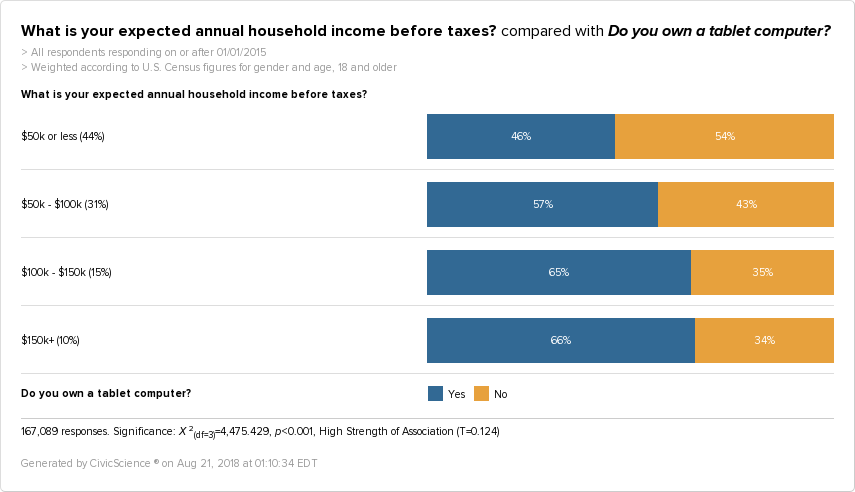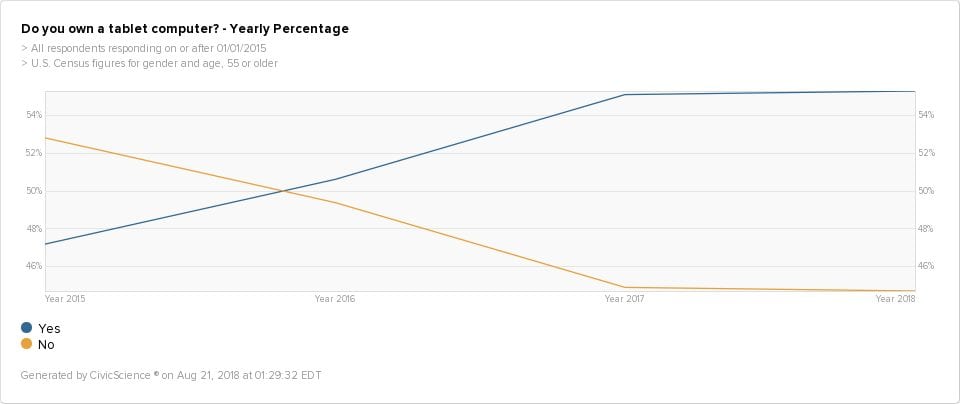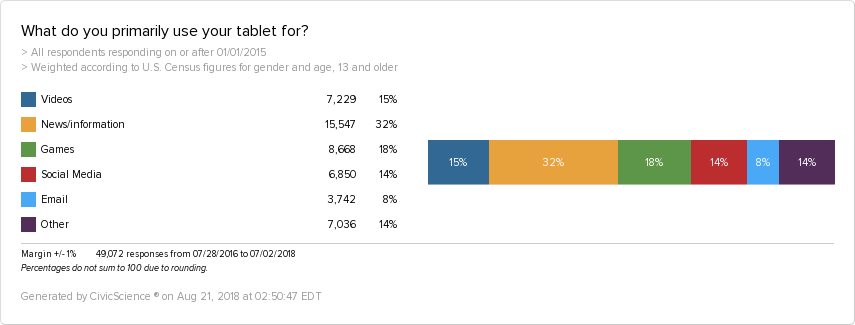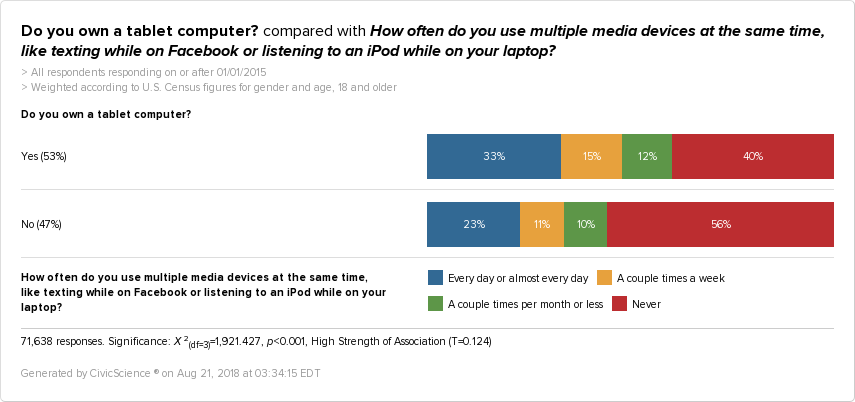Danielle Commisso reports in Civic Science:
Tablet ownership grew steadily since 2015, but peaked at the start of 2017, with 56% of adults owning a tablet. Since then, ownership has declined to 54% of U.S. adults and appears to be on a downward trajectory. Millennials and Gen Z were the most likely to primarily use tablets for watching videos, whereas Gen Xers and Baby Boomers were most likely to use them for news and information.Cost is a prohibitive factor driving down tablet ownership; (it) is correlated to income. Only 46% of those who make $50K or less per year owned a tablet, compared to 65% of those who make $100-150K.
Tablet computers have changed the digital landscape since their emergence in 2010, but now the market is losing steam.
In a survey of more than 269,000 U.S. adults, CivicScience found that tablet ownership has grown steadily since 2015, but peaked at the start of 2017, with 56% of adults owning a tablet. Since then, ownership has declined to 54% of U.S. adults and appears to be on a downward trajectory.
This downturn coincides with recent industry numbers. Apple, who still leads the market, along with most other tablet manufacturers, such as Samsung and Amazon, have all reported drops in tablet sales. Some analysts cite cost as a prohibitive factor driving down tablet ownership.
In fact, the survey found that tablet ownership is correlated to income. Only 46% of those who make $50K or less per year owned a tablet, compared to 65% of those who make $100-150K per year.
For price-conscious consumers, is it worth investing in a tablet when you could purchase a large-screen smartphone (a ‘phablet’) or a laptop with a touchscreen interface and greater computing power? Consider the rise in smartphone growth, to where an estimated 77% of U.S. adults now own a smartphone, as well as the availability of newer laptops with touchscreens, and cost seems like a plausible reason that fewer people are buying tablets.
Surprisingly, young people may play a significant role in the declining tablet market. When considering all age groups, Gen Xers appear to have the highest rates of tablet ownership, followed by Baby Boomers, then Millennials, and finally, Gen Z. Looking at the same tablet ownership graph, but only for the Baby Boomer population (55+), it’s clear that Baby Boomer ownership has stayed static since 2017.
However, the same isn’t true for Millennials (18-34), whose ownership rate has slid significantly since 2017 and is today closer to what it was in 2015, at the start of the survey.
Apple’s efforts to promote the iPad Pro as a device that could rival laptops, particularly for young people, may not resonate with that audience. In fact, even though the survey showed a slight increase in iPad favorability ratings in 2018, Millennials remain the most unfavorable of all age groups to the leading tablet, which holds the largest market share among manufacturers.
Apple has prioritized education as a target for a more affordable iPad version, and many schools across the country have already adopted tablets for learning, while businesses use tablets for POS systems. But when it comes to personal use, will tablets survive into the future, or will they be edged out by other devices? Looking at how and why people are using tablets now may help to shed some light.
In a separate survey of more than 47,000 tablet users ages 13 and up, CivicScience looked at different reasons for tablet use and found that “News/information” was the single most popular reason. In fact, users were twice as likely to use their tablet primarily to access news and information than they were for social media, videos, and email, as well as other unidentified reasons, such as reading, music, or shopping.
However, gaming ranked as the second-most popular reason and was most important to those under 18 years old, or Gen Z. But, both Millennials and Gen Z were the most likely to primarily use tablets for watching videos, whereas Gen Xers and Baby Boomers were most likely to use them for news and information.
Both men and women were most likely to use their tablets primarily for news and information. But women, who were 5% more likely to own tablets at all, reported higher rates of using tablets for games and social media, compared to men who use them more for videos and news and information.
More broadly speaking, survey results also indicate that Netflix users, streaming-video watchers, heavy social media users, people who shop more online than in stores, and iPhone owners may all be more inclined to own and purchase tablets.
Furthermore, tablet owners are more likely to report being addicted to their digital devices than those who don’t own tablets and to more frequently use multiple digital devices at once. Nearly half of tablet owners surveyed (48%) say they regularly use multiple devices at the same time, ranging from every day to a couple times per week, compared to 34% of those who don’t own tablets. It’s clear that tablets appeal to digital multi-taskers, which further suggests that tablets serve unique purposes for this large swath of owners rather than function as a primary digital source.
It’s safe to say that tablets have created a space for themselves, especially among people who are more avid digital consumers and early adopters, but their future is uncertain. Understanding more about how different people use tablets is likely key for manufacturers to maintain product viability, especially when it comes to digital natives of the Millenial and Gen Z generations.





























0 comments:
Post a Comment